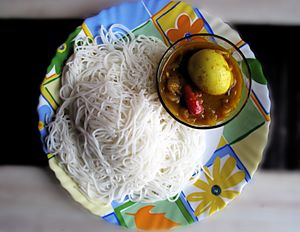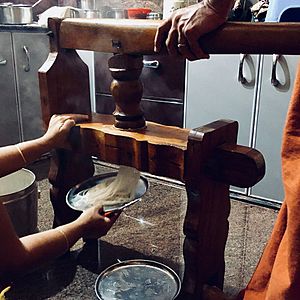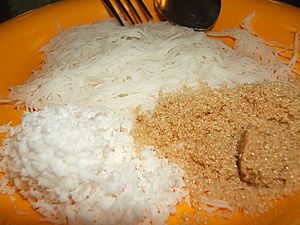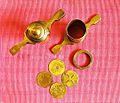Idiyappam facts for kids

Idiyappam served with curry
|
|
| Alternative names | Sevai, Santhagai, Putu mayam, putu mayang, "chomai", string hoppers |
|---|---|
| Type | Breakfast |
| Region or state | South India. Tamil Nadu, Kerala, Sri Lanka |
| Associated national cuisine | Kerala cuisine, Tamil cuisine, Sri Lankan cuisine |
| Main ingredients | Rice flour |
Idiyappam is a yummy dish made from rice flour. It's also called string hopper because it looks like thin strings or noodles. This dish comes from the southern parts of India, especially the states of Tamil Nadu, Kerala, and Karnataka. It's also very popular in Sri Lanka, Malaysia, and Singapore.
To make Idiyappam, rice flour is mixed with water and then pressed into thin noodles. These noodles are then shaped into a flat, round disc and steamed until they are soft and ready to eat. It's a popular breakfast or dinner food.
Contents
A Look Back in Time
Food experts say that Idiyappam has been around for a very long time. It was known in ancient Tamilakam (an old region in South India) as early as the 1st century AD. This means people were enjoying it almost 2,000 years ago!
Old writings from that time, called Sangam literature, mention dishes similar to Idiyappam. Also, a cookbook from 1025 CE, called Lokopakara, talks about how to make shavige (another name for these noodles) and even describes the special press used to make them.
Where Idiyappam is Popular
Idiyappam is a special food in many places. You'll find it all over Tamil Nadu, Kerala, Karnataka, and Sri Lanka. The name Idiyappam comes from the Tamil language. The word idi means "to beat" or "to press," and appam means "pancake." So, it's like "pressed pancake" noodles!
It's also often called noolappam or noolputtu. Nool means "string" or "thread" in both Tamil and Malayalam languages. This name perfectly describes its stringy look.
In Karnataka, it's known as Ottu Shavige in Kannada. In areas like Mangalore and Udupi, people call it semige or semé da addae in the Tulu language. In these places, it's often eaten with tasty chicken or fish curry, or a sweet coconut milk dish called rasayana.
Idiyappam is also a common breakfast in Malaysia and Singapore. There, it's called Puttu Mayam. People usually eat it with brown sugar and grated coconut.
How Idiyappam is Made
Making Idiyappam is quite simple! You need rice flour, salt, and water. Here's how it's generally done:
- First, mix the rice flour with hot water. You can add a little bit of ghee (a type of butter) for extra flavor. Don't forget to season it with salt.
- Knead the mixture until it forms a smooth dough.
- Next, put the dough into a special Idiyappam press. This press has small holes, and when you push the dough through, it comes out as thin noodles.
- You can press the noodles onto banana leaves or directly into an idli steamer. Some people like to add a little grated coconut on top before steaming.
- Finally, steam the noodles for about 5 to 10 minutes until they are cooked and soft.
In some parts of Tamil Nadu, like the Kongu Nadu region, they do it a bit differently. They steam the rice flour first, then press it into noodles. This is similar to how Ottu Shavige is made in Karnataka.
The Malaysian and Singaporean version, Putu Mayam, is made by mixing rice flour with water or coconut milk. This dough is then pressed through a sieve to create vermicelli-like noodles. Sometimes, juice from the fragrant pandan leaf is added for a nice smell and flavor. These noodles are steamed and served with grated coconut and sweet jaggery (a type of palm sugar).
Enjoying Idiyappam
Idiyappam is usually eaten for breakfast or dinner. It's often served with different kinds of curries, like potato, egg, fish, or meat curry. Sometimes, it's eaten with a spicy soup called rasam or a coconut chutney.
In the Malabar region of Kerala, people enjoy Idiyappam with sweet coconut milk and sugar. In other parts of Tamil Nadu, Kerala, and Sri Lanka, it's mostly eaten with spicy curries.
In Malaysia and Singapore, Putu Mayam is a popular street food. You can often buy it from market stalls or carts. It's usually served cold with grated coconut and palm sugar. In Indonesia, it's called Putu mayang and is served with palm sugar mixed with coconut milk.
You can even find special "instant" Idiyappam flour in stores. This makes it super easy to prepare this delicious dish at home!
Gallery
See also
 In Spanish: Putu mayam para niños
In Spanish: Putu mayam para niños







